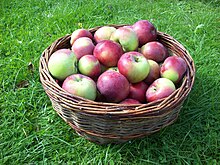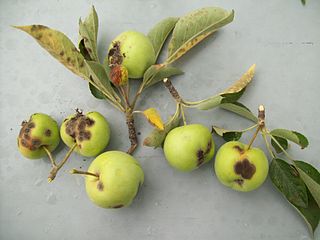
Apple scab is a common disease of plants in the rose family (Rosaceae) that is caused by the ascomycete fungus Venturia inaequalis. While this disease affects several plant genera, including Sorbus, Cotoneaster, and Pyrus, it is most commonly associated with the infection of Malus trees, including species of flowering crabapple, as well as cultivated apple. The first symptoms of this disease are found in the foliage, blossoms, and developing fruits of affected trees, which develop dark, irregularly-shaped lesions upon infection. Although apple scab rarely kills its host, infection typically leads to fruit deformation and premature leaf and fruit drop, which enhance the susceptibility of the host plant to abiotic stress and secondary infection. The reduction of fruit quality and yield may result in crop losses of up to 70%, posing a significant threat to the profitability of apple producers. To reduce scab-related yield losses, growers often combine preventive practices, including sanitation and resistance breeding, with reactive measures, such as targeted fungicide or biocontrol treatments, to prevent the incidence and spread of apple scab in their crops.

Cortland is a cultivar of apple developed at the New York State Agricultural Experiment Station in Geneva, New York, United States in 1898. The apple was named after nearby Cortland County, New York. It is among the fifteen most popular in the United States and Canada.
A rootstock is part of a plant, often an underground part, from which new above-ground growth can be produced. It could also be described as a stem with a well developed root system, to which a bud from another plant is grafted. It can refer to a rhizome or underground stem. In grafting, it refers to a plant, sometimes just a stump, which already has an established, healthy root system, onto which a cutting or a bud from another plant is grafted. In some cases, such as vines of grapes and other berries, cuttings may be used for rootstocks, the roots being established in nursery conditions before planting them out. The plant part grafted onto the rootstock is usually called the scion. The scion is the plant that has the properties that propagator desires above ground, including the photosynthetic activity and the fruit or decorative properties. The rootstock is selected for its interaction with the soil, providing the roots and the stem to support the new plant, obtaining the necessary soil water and minerals, and resisting the relevant pests and diseases. After a few weeks, the tissues of the two parts will have grown together, eventually forming a single plant. After some years, it may be difficult to detect the site of the graft although the product always contains the components of two genetically different plants.

Winesap is an old apple cultivar of unknown origin, dating at least to American colonial times. Its apples are sweet with a tangy finish. They are used for eating, cooking, and are especially prized for making cider.

An apple is a round, edible fruit produced by an apple tree. Apple trees are cultivated worldwide and are the most widely grown species in the genus Malus. The tree originated in Central Asia, where its wild ancestor, Malus sieversii, is still found. Apples have been grown for thousands of years in Eurasia and were introduced to North America by European colonists. Apples have religious and mythological significance in many cultures, including Norse, Greek, and European Christian tradition.

Liberty is a hybrid apple cultivar developed by the New York State Agricultural Experiment Station. It was a seedling produced in 1955 from pollinating 'Macoun' from 'Purdue 54-12' for the sake of acquiring Malus floribunda disease resistances. It was first released to the public in 1978.

White Transparent is an early-season cultivar of apple which is usually used for cooking due to its sharp taste. It is sometimes said to be the same as 'Yellow Transparent', but 'Yellow Transparent' is sometimes described differently, with fine rather than coarse flesh, and a sub-acid rather than acid flavour. Weight 75 g,

Lord Lambourne is an apple cultivar with a sweet sharp flavor. It was raised by Laxtons Brothers Ltd in 1907 in Bedford, England. Received a Royal Horticultural Society Award of Merit in 1923.
Applecrabs are various hybrids between crabapples and apples. They are bred for varying reasons, including disease resistance and use in cold climates because they are often hardier than apple trees and their fruit has the good eating qualities of apples.

Pristine apple is a hybrid cultivar of 'Co Op 10' x 'Camuzat' domesticated apples, which are descendants of the 'McIntosh' apple and the 'Starking Delicious'. This cultivar was developed and patented in the United States by the PRI disease resistant apple breeding program, in Indiana, United States in 1994, for its resistance to apple scab. It is susceptible to cedar-apple rust.

'Akane', also known as 'Tokyo Rose', 'Tohoku No.3' and 'Prime Red', is a Japanese cultivar of domesticated apple, that according to Orange Pippin is one of the best early season apples.

'Worcester Pearmain' is an early season English cultivar of domesticated apple, that was developed in Worcester, England, by a Mr. Hale of Swanpool in 1874. It was once the most popular cultivar in England for early autumn harvest and is still popular to keep in the garden. It has been extensively used in apple breeding.

'Duchess of Oldenburg' is an old Russian cultivar (1750–1799) of cultivated apple which has attractive streaks of yellow and red. It was commonly but not universally known in America simply as 'Oldenburg' after the American Pomological Society listed that as the official name, a name also used for the 'Geheimrat Dr. Oldenburg' cultivar. The skin of the apple is more prominently striped than that of 'Geheimrat Dr. Oldenburg'.

'Ariane' is a modern cultivar of domesticated apple that was recently developed in France for scab resistance.
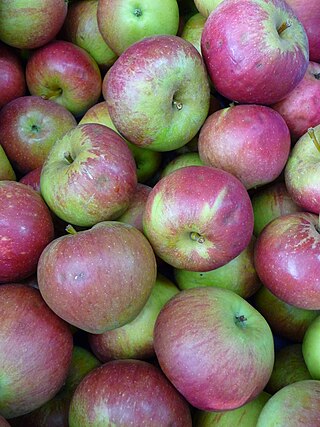
Fiesta is a modern cultivar of domesticated apple which is often marketed as Red Pippin. It was developed in the United Kingdom by breeders at the East Malling Research Station, combining the Cox's Orange Pippin with the Idared apple. According to the Orange Pippin website, it is one of the best Cox's style apples, but much easier to grow having good disease resistance.

'Delbard Jubilée' or 'Delgollune' is a modern French cultivar of domesticated apple which was developed in 1964 by Delbard nurseries. It is not the same as the Jubilee apple that was developed in Canada.
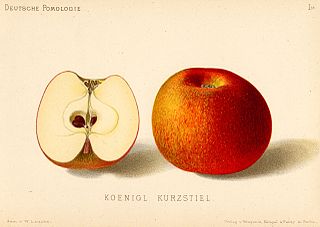
Court Pendu Plat is an extremely old French cultivar of domesticated apple that was first recorded in 1613. The cultivar definitely dates back to earlier than the 17th century, and was probably cultivated by the Romans. It is known for its intense flavor which mellows with storage.

Red Astrachan is a cultivar of domesticated apple of either Russian or Swedish origin, which is an early season apple, juicy, tart and mealy texture with pleasant flavour, and use for eating, cooking and cider. It is medium-sized, crimson colored. As all the early season apples, it is not good for storage. It is known by several other names including 'Abe Lincoln', 'American Red', and 'Waterloo'.
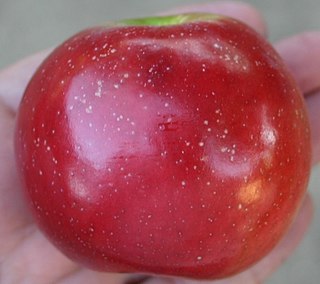
Enterprise is a modern bred, late-ripening and attractive, red cultivar of domesticated apple with excellent fruit quality combined with disease resistance to scab, cedar apple rust, fire blight and some resistance to powdery mildew. The fruit is large and attractive and retains excellent fresh quality for up to six months at 1°C. Its moderate acidity at time of harvest mellows in storage, and it is best after one month of storage.

The 'Prima' apple is one of the modern disease resistant cultivars of domesticated apple which was bred by the PRI disease resistant apple breeding program in 1958. The disease resistance against apple scab has since been broken.
